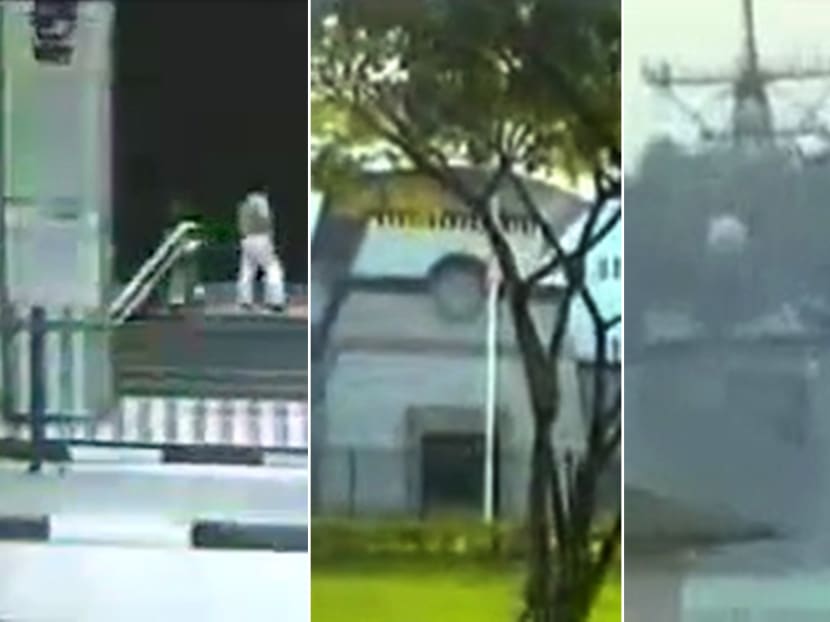JI arrests, 20 years on: ISD releases new details on terrorist group’s plans to attack nearly 80 S’pore targets
SINGAPORE — The Internal Security Department (ISD) has released newly declassified details of terror plans by the Jemaah Islamiyah (JI) organisation against about 80 targets here. These include previously unreleased statements by JI detainees and surveillance footage obtained by the group as it plotted against Singapore.

Collage of video screenshots taken from surveillance footage filmed by Jemaah Islamiyah members of (from left) Yishun MRT Station, the United States Embassy in Singapore and Sembawang Wharf.
- Jemaah Islamiyah had identified close to 80 targets in Singapore and came close to carrying out attacks, the Internal Security Department said
- They include Yishun MRT Station, Changi Airport and the water pipelines between Singapore and Malaysia
- New details of ISD’s dragnet against the shadowy group 20 years ago was released on Saturday
- Footage and pictures of reconnaissance efforts by JI members reveal a well-coordinated effort
SINGAPORE — The Internal Security Department (ISD) has released newly declassified details of terror plans by the Jemaah Islamiyah (JI) organisation against about 80 targets here. These include previously unreleased statements by JI detainees and surveillance footage obtained by the group as it plotted against Singapore.
From trying to provoke war with Malaysia to debilitating Singapore’s key infrastructure and economy, JI’s targetting of Singapore remains the nation’s “closest shave with transnational Islamist terrorism to date”, ISD said on Saturday (Dec 4).
In a report commemorating the 20th anniversary of its dragnet that smashed JI operations in Singapore, ISD said that the terrorist group had carried out extensive reconnaissance for many of the almost 80 targets JI had identified here.
Previously, ISD had provided some details on these plots, stating in a 2003 White Paper presented to Parliament that JI had “at least six plans”.
For example, the White Paper documented how the plans and surveillance footage to attack a shuttle bus at Yishun MRT Station wound up in Afghanistan, only to be discovered by American military forces there.
“In making these plans, Jl relied heavily on video reconnaissance of the targets, usually making recordings over several visits and making a final composite video for final preparations and planning,” ISD said then, though it had waited until now to release the video footage.
PLOTS AGAINST TARGETS IN SINGAPORE
The terrorist organisation gained notoriety after the Sept 11, 2001 attacks in the United States by the Al Qaeda terrorist group, which had strong links to JI. Several prominent JI members trained with Al Qaeda in Afghanistan, which had also given instructions and support to JI operatives here.
However, JI's earliest plans to carry out attacks in Singapore date back to the mid-1990s, long before the events of 9/11, ISD said.
1. Attacking shuttle buses ferrying US personnel between Sembawang Wharf and Yishun MRT Station
One of JI’s earliest known plans here was to attack bus services taking American military personnel and their families in the Sembawang area to Yishun MRT Station.
A Singapore JI member hatched this plan in 1997. Then, other members began drawing up maps of the MRT station and used a video camera to survey the station and its surroundings.
Special attention was given to areas where explosives could be placed, ISD disclosed.
A three-minute video taken by a JI member includes a man describing the vulnerabilities at Yishun MRT Station, while regular Singaporeans go about their day around him.
It shows the buses and the drop-off points for the US personnel, bicycle parking lots and drainage areas where bombs could be hidden, and a nearby temple car park where “it would not be suspicious if there was a bicycle or motorcycle parked there”, the male voice says.
One detainee, known as Jameel, later told ISD that the initial plan was to pack explosives in either a stolen motorcycle or using a dustbin, detonating it when the US personnel got on or off the bus.
The group had also considered using a suicide bomber or rigging an unattended bus with explosives.
A copy of the videotape was also discovered by US forces in Afghanistan, along with notes written in Arabic, such as a detailed map of the MRT station, the route taken by the shuttle bus as well as the frequency of the bus and Singapore’s traffic system.
This indicated that Al Qaeda, which was present in Afghanistan at the time, was briefed on the attack plans.
2. Attacking water pipelines to provoke war between Singapore and Malaysia
Riduan Isamuddin, known as Hambali, was one of the key JI leaders in the region who orchestrated the 2002 Bali bombings in which 202 people died.
He wanted to conduct attacks in Singapore that would implicate Malaysia, causing animosity and provoking war, ISD said.
“He believed that JI could then take advantage of the instability to overthrow the secular governments of Singapore and Malaysia and establish an Islamic state.”
Reconnaissance photographs released by ISD on Saturday showed the PUB Woodlands booster station, Bukit Panjang service reservoir along Fajar Road and the water pipeline at Bukit Timah Nature Reserve. The 2003 White Paper had also named the water pipelines at the Causeway and the PUB Bukit Timah Water Works opposite KK Women’s and Children’s Hospital as targets.
Four JI members, including Mohammad Aslam Yar Ali Khan who is still being detained today, posed as joggers and filmed these locations.
A JI detainee who had filmed the water pipelines told the authorities that the purpose of “casing” the pipelines was to blow them up in order to cut the water supply between Singapore and Malaysia, and was aimed at causing chaos in both countries.
3. Bombing the US, Israeli embassies and the high commissions of UK and Australia
One plot that gained significant traction following the 9/11 attacks came at the urging of Al Qaeda operative “Sammy”, whose real name is Mohammed Mansour Jabarah, a Canadian.
It involved the use of truck bombs to attack the US and Israeli embassies, the Australian and British high commissions, and commercial buildings that housed American firms, ISD said.
The attacks were scheduled as soon as December 2001, three months after the US attacks.
By the time of their arrests, Singapore JI members had already taken steps to procure 17 tonnes of fertiliser intended to make the truck bombs.
This was done on the instructions of a foreign JI bombmaker identified as Fathur Rohman al-Ghozi, who was known by his alias Mike. Both Mike and Sammy were arrested overseas with the aid of the information provided by ISD.
4. Attacking US naval vessels and aircraft in Singapore
In early 2001, Singapore JI members revived plans dating back to the mid-1990s to attack US naval vessels docked here.
The impetus came from two foreign operatives who had approached a Malaysian JI leader, who in turn approached the Singapore cell for information on these vessels.
This was a pattern for the JI cell in Singapore, in which members here would perform the legwork to facilitate a possible attack by foreign elements.
A JI detainee, given the pseudonym Alif, later told ISD officers: “He wanted us to get information about Sembawang Naval Base. He also wanted us to videocam the naval base… If we could get the schedule of American warships coming in… from where they would come.”
He added that those conducting the reconnaissance had to share the cost of buying a video camera and shave their beards to avoid detection. JI members had also observed Sembawang Wharf from Johor.
The 2003 paper noted that one of the items discovered in the possession of JI leader was a map, which indicated a possible “sea-borne bomb attack using a small vessel against US ships travelling eastwards from Sembawang Wharf”.
One piece of video footage of Sembawang Wharf released by ISD on Saturday showed fuzzy images of what appeared to be a docked Oliver Hazard Perry class guided missile frigate, used by the US navy.
There was also footage of Changi Naval Base as well, taken by a JI member while taking a ferry from Tanah Merah Ferry Terminal to Johor. Copies of the surveillance videos were later sent to the JI network in Malaysia.
Separately, one JI member — who worked as a technician with Singapore Technology Aerospace Systems — had also taken more than 50 photographs of Paya Lebar Airbase that were meant to support a potential attack on US aircraft.
5. Attacking the Ministry of Defence headquarters
ISD said that JI had also planned to “impair Singapore’s military capabilities” by targeting the Ministry of Defence (Mindef) headquarters at Bukit Gombak.
In 2001, JI members surveyed the perimeter and exits of the headquarters, and had also tried to gain entry into the compound on several occasions “under the cover of courier services”.
“One JI member had also tailed a Mindef officer from the HQ all the way to Tampines,” ISD said.
This was because a senior JI leader was considering a plan to place explosives in the Mindef officer’s car and detonate them when the car entered the Mindef compound.
6. Attacking Changi Airport and other economic infrastructure
JI wanted to attack Singapore’s economy by targeting Changi Airport and the radar station on Biggin Hill, which is now the Changi Airport’s Air Traffic Control Centre.
These locations had been surveyed on several occasions between 1999 and 2001, with JI “relying on members with insider access to facilitate its terror plans”.
Two JI members, who were working for the Civil Aviation Authority of Singapore (CAAS) and an international courier company, were assigned to carry out the reconnaissance.
They managed to survey the secure areas within the airport where they could plant bombs, including at the control tower of the airport.
JI was also able to obtain a map of the airport’s cargo complex, which had markings where the aviation fuel tanks were.
One JI detainee said to officers: “Although (another member) did not get into specifics, I was fully aware that foreigners would carry out the sabotage attacks… I was aware that the recce that was conducted by us was important, as it provided details of the premises (and) the detailed layout of target areas.”
Other strategic targets included the Singapore American School, the MRT system including its operations control centre, and Jurong Island.
7. Crashing a hijacked plane in Changi Airport
Angered by the ISD operation on Dec 8, 2001 against JI members, the terrorist organisation sought to launch retaliatory attacks against Singapore.
Hambali, one of the JI leaders in the region, urged Singapore JI members to persist with the earlier plan on the various foreign missions in retaliation.
However, the plan was foiled after ISD shared information on JI bombmaker Mike that led to his arrest in the Philippines. Explosives meant to be used in the Singapore attack were discovered during his capture.
Mas Selamat Kastari, a JI leader who had fled to Johor in Malaysia at the time, also planned to hijack a plane from Bangkok in Thailand and crash it into the control tower of Changi Airport in response to the ISD arrests.He bought five business-class tickets for the flight from Thailand, but was forced to abort after ISD learnt of the planned hijacking from two detainees.
A detainee, given the pseudonym Johan, later told ISD of Mas Selamat’s plan: “Once we have hijacked the aeroplane, we were going to crash (it) into the control tower of Changi Airport. If we could not… we would crash the aeroplane anyway because we did not want to get caught.”
HUNTING DOWN FUGITIVES
Days after the 9/11 attacks, an alert member of the public tipped off ISD on a man who had claimed to know Al Qaeda leader Osama bin Laden. The department began watching the man, Mohammad Aslam Yar Ali Khan, who left for Afghanistan on Oct 4, 2001.
After Aslam’s detention in Afghanistan was reported in the media on Dec 3, ISD began its operations against Aslam’s associates on Dec 8.
It picked up 23 people for questioning during its first wave of arrests, 13 of whom were found to be active JI members and were detained under the Internal Security Act (ISA).
Another 21 people were arrested in the second wave in August 2002, of whom 17 were JI members and one was a member of another terrorist organisation Moro Islamic Liberation Front.
“Without the ISA, we would likely only have been able to arrest and charge the JI members after they had conducted their attacks,” ISD said.
The ISD’s operations did not stop after the JI network in Singapore was crippled, as it turned its attention to JI fugitives who fled the country, according to new information provided.
Through co-operation with regional security agencies and the investigative leads that came from ISD’s interviews with JI detainees, many were caught overseas and deported to Singapore.
“For some of the JI fugitives, ISD worked with their families and other helpful parties wherever possible, to persuade these individuals to return to Singapore,” the department said.
At least four JI members returned to Singapore after speaking to their families. ISD said that it had secured the return of more than 20 Singaporeans who had fled the country in the wake of the arrests, except for one who is still imprisoned in Indonesia for terrorism offences.











